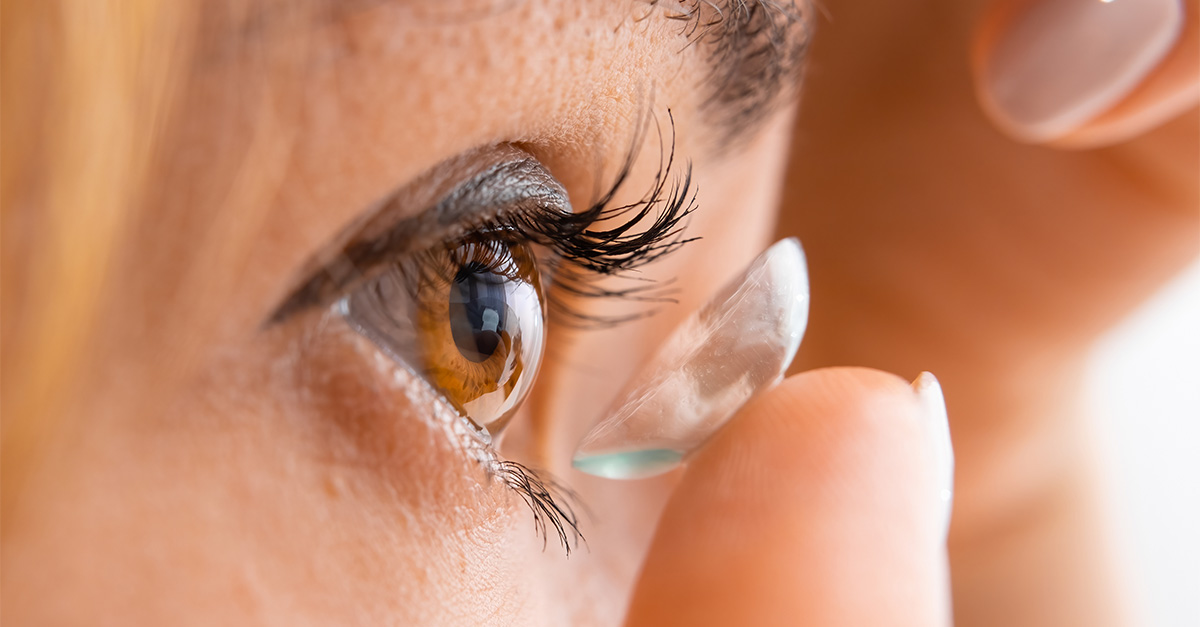Contact lenses offer the freedom to forgo glasses, which is convenient if you’re an athlete, outdoors enthusiast, or simply prefer not to have frames on your face. But they do come with a caveat: wearing contacts can increase your risk of developing dry eye syndrome. If you experience symptoms like grittiness, burning, or a stinging sensation while you’re wearing your contacts, there are steps you can do to find relief
Dry Eyes, Contact Lenses: What’s the Connection?
The relationship between dry eyes and contact lenses isn’t always straightforward. There are three types of dry eye: reduced tear production, excessive evaporation, and imperfect tear composition. Contact lens wear can contribute to reduced tear production and subsequent dry eyes, other factors such as environmental irritants, certain medications, visual tasks, and hormonal changes can also lead to dry eyes.
Further, it’s possible for contact lenses to both worsen existing dry eye and to spur new cases. Since contact lenses are positioned in the middle of your eye’s tear film, they can disrupt the production of tears and create friction between the lens and your eye’s surface. The tears your eyes do produce may evaporate even faster, doubling the drying effect.
You may not have to give up contacts completely, though — try the steps below first.
How to Manage Dry Eyes with Contact Lenses
Select the Right Contact Lenses
There are many types of contact lenses available. Rigid gas permeable (or “hard”) contact lenses offer superior durability, but soft lenses are preferred by the majority of contact wearers due to their improved comfort. One type of soft lenses in particular, daily disposables, have the highest surface water retention properties, which minimizes their impact on tear production. If you’re currently using a different type of lenses, our eye care specialists can walk you through alternate options to determine if a switch might be right for you.
Wear Only As Directed
Wearing your lenses exactly as instructed can help prevent irritation and infections. Sleeping in your contact lenses, for instance, can lead to serious eye infections by restricting the flow of moisture and oxygen to your eyes. Not only does this lead to discomfort, but it also hinders your eyes’ ability to fight off bacteria. Carefully follow the manufacturer’s and eye care specialist’s instructions for your specific contact lens type to promote healthy, comfortable wear.
Maintain Your Lens Care Routine
Infections caused by poor contact lens care can bear symptoms similar to those of dry eye. Keep all lens-related irritation at bay by following the “Rs” of contact lens care:
- Rub the lenses with a lens cleaning solution using clean hands each time you remove them.
- Rinse the lenses in an approved solution.
- Replace the lenses at the directed intervals, and swap out your lens case the first of every month.
- Rest your eyes periodically to give them a break from lens wear.
Consider Dry Eye Treatments
For quick relief from dry eye symptoms, over-the-counter eye treatments may be worth a try. Preservative-free artificial tears, for example, can be used with contact lenses to moisturize your eyes. Dry eye contact lens drops may also soothe periodic episodes of irritation — just ensure the formula you’ve chosen is approved for use with contact lenses.
Should your dry eye symptoms persist, however, you may need a prescription treatment. From in-office treatments to prescription-strength eye drops, there are several solutions available we can identify with you.
Schedule a Dry Eye Appointment With Eye Consultants of Atlanta
If you’re experiencing persistent discomfort from a suspected case of dry eye, turn to Eye Consultants of Atlanta for relief. Schedule an appointment with one of our contact lens specialists to discuss the best treatment option for you, or call (404) 351-2220 to make an appointment.

